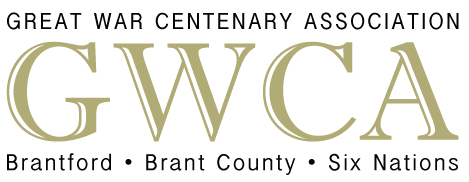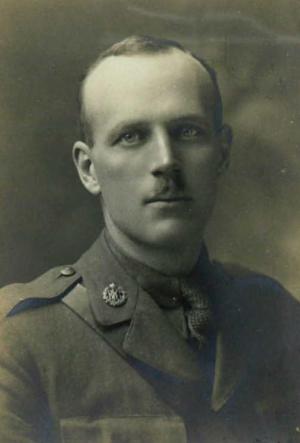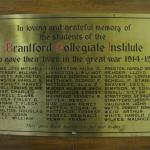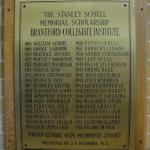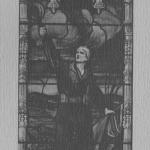BX December 23, 1915
Ordered to Join the British Aerial Squad – Frederick Stanley Schell Leaves Next Week, Having Been Selected for Duty
Frederick Stanley Schell of this city, a member of the Canadian aviator squad, received instructions today to report at Toronto next week to leave on Saturday for the old land, there to be attached to the British aerial forces.
He enlisted some time ago and was to have taken a course at the Curtis School in Toronto. Just as he was about to commence his studies the school was closed owing to the approach of winter. He has since been one of the few selected to go to the old land to take up his training, all expenses being borne by the British government.
BX March 6, 1919
Scholarship as Memorial to Lieutenant Frederick Stanley Schell – “Stanley Schell Memorial Scholarship” for Pupils of Collegiate Institute
The Stanley Schell Memorial Scholarship has been instituted at the Brantford Collegiate Institute.
It is founded in memory of Stanley Schell, lieutenant in the 130th Heavy Battery of the Royal Garrison Artillery, who was killed in the service of his country at Maricourt, on August 27, 1918.
A fund to yield an annual revenue of $50 has been placed in charge of the Royal Loan and Savings Company, Brantford; this revenue to be awarded to the pupil of the Brantford Collegiate Institute who takes the highest standing at the midsummer departmental examinations of the middle school, under the following conditions:
1. That the pupil taking this standing shall proceed to an upper school course during the following school year, $25 to be paid by the Royal Loan & Savings Company to the grantee in September on the order of the principal of the Collegiate Institute, and $25 in the following April; but, in case the pupil to whom the scholarship is first awarded should cease to attend the school, it shall revert to the pupil in attendance who has taken the standing nearest the first.
2. That the number of papers to be considered shall be ten of those prescribed for junior matriculation in Arts, or Normal entrance, and if more than ten papers be written, the ten on which the highest standing is attained, and these only, shall be included.
3. That Normal school entrance papers shall be regarded as equivalent to matriculation in the same subjects, the marks of the Latin paper, or papers in Art at the Normal entrance examination being raised proportionately to conform with the assignment of marks in Latin at the matriculation examination.
4. That in the event of such changes in the prescription of work as would render the conditions of clauses 2 and 3 impracticable or unfair; these conditions may be modified as may seem best in the judgement of the staff or the Brantford Collegiate Institute.
BX September 27, 1920
Memorial Window to Heroic Fallen Unveiled at Brant Avenue Church – Chancellor Bowles of Victoria College Officiated at Official Recognition of Nine Members of the Church Who Gave Their Lives in the Great War – A Ceremony Pregnant With Meaning
In dedication to the nine men of Brant Avenue Methodist Church who gave their lives in the Great War, a memorial window was unveiled in that church at the morning services yesterday. Rev. Chancellor Bowles of Victoria College, Toronto, gave the message of consolation to the friends of the soldiers whose memory he extolled and Major A.E. Lavelle, D.D., and Major E. Sweet both in uniform, unveiled the window. The congregation filled the church to the last pew and each one could not fail to receive, from the simple and impressive ceremony, a strong, new motive for keeping alive what Chancellor Bowles called a great and glorious memory.”
Deeply impressive and heart soothing was the whole ceremony. Rev. J.D. Fitzpatrick, the pastor of the church, was in charge and the choir gave special music, including solos by Miss Reba Force and Miss Margaret Stephen, the latter of Toronto. The military significance of the event was emphasized by the number of men attending in uniform. Besides Major Sweet and Major Lavell, places of prominence were given to Col. M.A. Colquhoun, D.S.O., C.M.G., Lieut.-Col. M.E.B. Cutcliffe, Major Jordan, Lieut. K.V. Bunnell, Lieut. Donald Waterous, Lieut. Charles Sheppard, Capt. (Dr.) Leonard Coates, Capt. Dufferin Slemin, Lieut. Fred Pinnell, Capt. Morley Verity and Sergt. James Hitchon, Nursing Sister, Captain Annie Hartley, was also present.
The Decorations
A special committee had spent much time in making the church beautiful, draping the chancel in flags and wreathing maple leaves over the window and around the memorial tablets formerly erected. Bouquets of mauve and white and pink and white asters were placed on the sill of the window.
The Sermon
Following the solemn prayer by Rev. J.D. Fitzpatrick and the choir offerings, Rev. Chancellor Bowles preached a most impressive sermon.
The dedication of the memorial, said Dr. Bowles, was promoted by instincts of love and gratitude and loyalty that sought to keep in recollection the names of those who were gone, their voices, their faces and the deeds they had done. Thoughts of them were like a benediction after prayer, for memories such as theirs soothed and elevated and enriched men’s lives and kept them in touch with the living past. Many memorials were being erected, he said, from simple tablets to costly community halls, churches and arches; yet the outward form mattered little, what counted was the appreciation and admiration of those who raised them. Every memorial was erected “Lest we forget.”
It was not likely this generation would ever see such another war, it was the grimmest and most awful thing men had ever faced; they had been overwhelmed by its terrible destruction and death. This ceremony was held to lead others to know its meanings and learn its lesson well – “Lest we forget.” Drawing his bearers to think of the many elements that entered into the cause of the war, the struggle, said the Chancellor, had written its own inner meaning. Humanity could live in safety on this earth only as a spiritual and moral force; there must be a right relationship among the nations; men had come to feel the sense of the ultimate value of what was right and what was fair. “We know what conceptions and ideals moved our boys,” Dr. Bowles went on. “They had the sense of human value. Most of them were scarcely young men, they were only boys. Life had no problems for them yet; the iron had not entered into their souls. Now they make one small portion of those who like in Flanders’ Fields. They had not lived their lives as some listening to me have almost done, they poured out the wine of youth, life’s passions; nor” he said, “will you cease to think of them as young and fair. From the many letters I read written by Victoria College students, I was struck by the cheer and the steadfastness to duty they expressed. From one I have here, written to the soldier’s mother, before the great struggle of August 8, he concluded, ‘a great triumph will take place and I shall have a part in it.’ Remember”, said the Chancellor in closing “that was the spirit that actuated them through it all.”
The Unveiling
Major Lavell and Major Sweet conducted the unveiling ceremonies, the former giving a brief address and the latter reading the names and drawing aside the Union Jack which covered the memorial window.
In beginning his remarks Major Lavell referred to Major T. Harry Jones, who had so much to do with the memorial window, but who had not lived to see the completion of the work. He said that out of the many thoughts that crowded in upon his mind there were but three he had time to express. The first was the sorrow that those present must feel who were nearest and dearest to the men whose names were on the memorial. This sorrow and perplexity at death was as old as the race. To this sorrow he had little to give but sympathy. Possibly if they would find the secret of Calvary and see our Lord’s death as victory and not defeat, they would have light and much comfort. The second was that the front line areas made a school the like of which existed nowhere else. It tested, disciplined and changed every man. They learned to know real values, what was worth retaining and what might be well given up. The third was that these brave young men having passed through this school that most of those present had not passed through, and therefore knew not, willingly faced death and died doing their duty, which to them was far preferable to mere living. Could their loved ones here not have faith in their faith and even in their sorrow and ignorance believe in the light seen by those who had fearlessly walked through the valley of the shadow?
Major Lavell quoted from Sir Arthur Currie’s message to the Canadian soldiers, delivered on March 27, 1918. How true, he said, his finals words had become and how appropriately they had been chosen for the inscription on the window: “You will not die, but will step into immortality.”
Impressively and clearly Major Sweet read the roll of those whose names were inscribed on the tablet:
Harold Staples Brewster
Alexander Finletter Brown
Hugh Dalton Livingston
Lawrence Wilmot Livingston
Joseph Howard Pinnell
Earl Pettit Pitcher
Harold Brant Preston
Frederick Stanley Schell
Egerton Vaughan
As the window was revealed and the names were called, the notes of the “Last Post” were sounded by Sergeant Beech of the Dufferin Rifles.
The committee of arrangements consisted of Mrs. R.S. Schell, Mrs. W.C. Livingston, Mrs. J.J. Vaughan, Messrs. W.S. Brewster, T.H. Preston, E. Sweet and C.S. Slemin.
BX July 26, 1923
Graves of Heroes Tenderly Cared For – Two Brantford Visitors Bear this Testimony – Canadian Red Cross Renders Great Service
Mrs. R.S. Schell and Miss Mary Schell, 147 Brant Avenue, who have just returned from a trip to Europe, where their special mission was to visit “the hallowed acres,” in which the heroic dead rest who fell in the Great War, speak in the highest terms of the magnificent work that the Canadian Red Cross society is accomplishing in connection with the Canadians visiting these sacred scenes. The objective in view is exemplified by the following card:
“The Canadian Red Cross Society has an office at the Bank of Montreal, 9 Waterloo Place, London, S.W.I.
“Every assistance is given at this office and all arrangements made in conjunction with the St. Barnabas hostels, for pilgrims visiting graves in France and Belgium. All applications should be made personally for by letter to the above address.
“This brief outline does not begin to tell of the wonderful and the efficient manner in which everything is carried out.
“At the office above mentioned, every assistance is given, free passports obtained and also all accommodation secured, when necessary. The whole system is one which makes a pilgrim quite simple, even for those who have never travelled before.
“Intending visitors to Canadian graves are advised to communicate with Mrs. David Fraser at 9 Waterloo Place, giving as many days notice of their visit as possible, and enclosing full details of the grave to be visited. A free passport is obtained for those next of kin and English money is exchanged for French, while all information can be obtained in detail as to expenses. At Calais or Boulogne the traveller is met by a St. Barnabas worker, wearing the badge of the society, who passes the visitor through the customs, with conveyance to hostel or train. Subsequent movements depend on the locality of the cemetery to be visited. The devoted assistants, many of them volunteers, speak French and English and all trouble is avoided in every possible way. The first pilgrim under this system was a lady who had been asked $175 by a London bureau for a visit to Loos. Under the method of which this is a description less than $70 was the cost. In addition to the material aspect there is also the sympathetic and tactful atmosphere created by the workers.
“The hostels, organized by Rev. M. Mullineux, M.C., are comfortable stopping places, with cleanly, adequate accommodation and excellent meals, the entire service being rendered at minimum cost.”
Beautiful Cemeteries
The Brantford travellers visited eleven cemeteries in France and Belgium, and in all of them there was the same evidence of reverential care and treatment, under direction of the Imperial War Graves commission. At the time of the armistice there were 3000 cemeteries besides thousands of isolated graves, and these have all received effective attention. In each of the cemeteries there has been, or will be, erected the “Cross of Sacrifice,” and there is also a large boulder on which is inscribed “Their name liveth for evermore.” Many of these last resting places are miles from the nearest railway station and can only be found by those who know the locality. The headstones, 2 ft. 8 x 1 ft. 3 in., bear the soldier’s name, rank and number and the date of his death and age, if desired; also the badge of his regiment and the emblem of his faith. In the case of Canadians, the maple leaf is carved. The headstones are set row upon row, with beautiful lawn between the spaces and many lovely floral borders. The border flowers, in bloom when Mrs. Schell and her daughter visited the cemeteries, were violets, pansies, forget-me-nots and pinks. Canterbury bells, snapdragons and roses were also much in evidence. Shrubs and trees still further add to the effect.
Over 1300 gardeners – who consist of veterans, were at work in the various cemeteries last year, and their operations represented an area of 96,000 square miles. There is a most perfect system at each cemetery. A plan is located in a box at the gate entrance, and this shows each plot, row and grave, such as “Plot A. Row 1, grave 11.”
Those, whose loved ones rest over yonder, with tens of thousands of comrades who gave their lives that liberty might live, can be rest assured that everything that human care can accomplish has been done in tribute to their undying fame. Each and all of the graves could not be more tenderly looked after, even if located in some adjacent plot to the homes of the bereaved.
This is the comforting message which Mrs. Schell and her daughter have brought back to Brantford families, the last resting place of whose hero members they visited.
